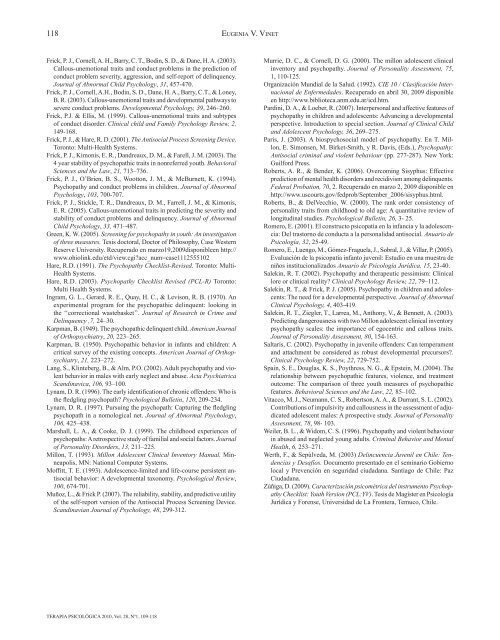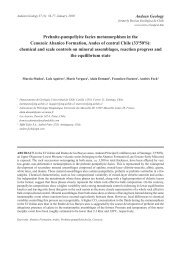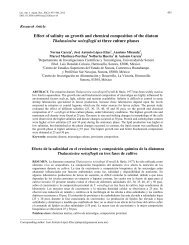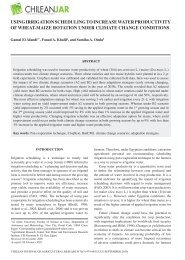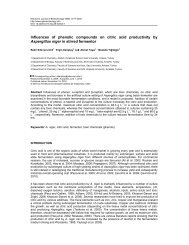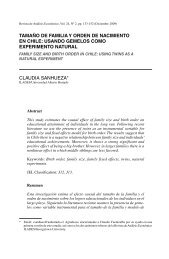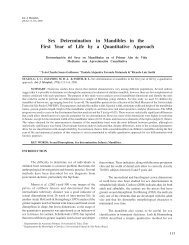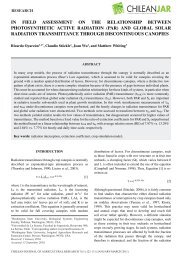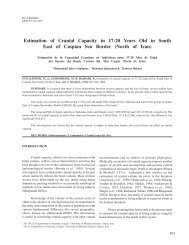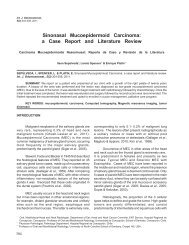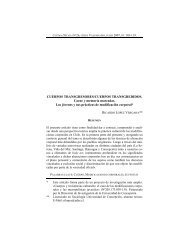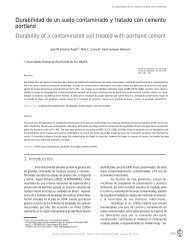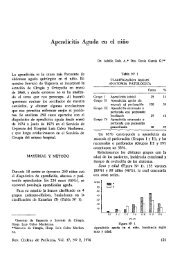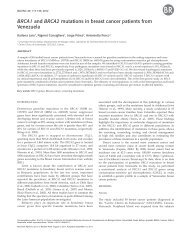Psicopatía infanto-juvenil: avances en conceptualización ... - SciELO
Psicopatía infanto-juvenil: avances en conceptualización ... - SciELO
Psicopatía infanto-juvenil: avances en conceptualización ... - SciELO
You also want an ePaper? Increase the reach of your titles
YUMPU automatically turns print PDFs into web optimized ePapers that Google loves.
118<br />
Frick, P. J., Cornell, A. H., Barry, C. T., Bodin, S. D., & Dane, H. A. (2003).<br />
Callous-unemotional traits and conduct problems in the prediction of<br />
conduct problem severity, aggression, and self-report of delinqu<strong>en</strong>cy.<br />
Journal of Abnormal Child Psychology, 31, 457-470.<br />
Frick, P. J., Cornell, A.H., Bodin, S. D., Dane, H. A., Barry, C.T., & Loney,<br />
B. R. (2003). Callous-unemotional traits and developm<strong>en</strong>tal pathways to<br />
severe conduct problems. Developm<strong>en</strong>tal Psychology, 39, 246–260.<br />
Frick, P.J. & Ellis, M. (1999). Callous-unemotional traits and subtypes<br />
of conduct disorder. Clinical child and Family Psychology Review, 2,<br />
149-168.<br />
Frick, P. J., & Hare, R. D. (2001). The Antisocial Process Scre<strong>en</strong>ing Device.<br />
Toronto: Multi-Health Systems.<br />
Frick, P. J., Kimonis, E. R., Dandreaux, D. M., & Farell, J. M. (2003). The<br />
4 year stability of psychopathic traits in nonreferred youth. Behavioral<br />
Sci<strong>en</strong>ces and the Law, 21, 713–736.<br />
Frick, P. J., O’Bri<strong>en</strong>, B. S., Wootton, J. M., & McBurnett, K. (1994).<br />
Psychopathy and conduct problems in childr<strong>en</strong>. Journal of Abnormal<br />
Psychology, 103, 700-707.<br />
Frick, P. J., Stickle, T. R., Dandreaux, D. M., Farrell, J. M., & Kimonis,<br />
E. R. (2005). Callous-unemotional traits in predicting the severity and<br />
stability of conduct problems and delinqu<strong>en</strong>cy. Journal of Abnormal<br />
Child Psychology, 33, 471–487.<br />
Gre<strong>en</strong>, K. W. (2005). Scre<strong>en</strong>ing for psychopathy in youth: An investigation<br />
of three measures. Tesis doctoral, Doctor of Philosophy, Case Western<br />
Reserve University. Recuperado <strong>en</strong> marzo19,2009disponible<strong>en</strong> http://<br />
www.ohiolink.edu/etd/view.cgi?acc_num=case1112555102<br />
Hare, R.D. (1991). The Psychopathy Checklist-Revised. Toronto: Multi-<br />
Health Systems.<br />
Hare, R.D. (2003). Psychopathy Checklist Revised (PCL-R) Toronto:<br />
Multi Health Systems.<br />
Ingram, G. L., Gerard, R. E., Quay, H. C., & Levison, R. B. (1970). An<br />
experim<strong>en</strong>tal program for the psychopathic delinqu<strong>en</strong>t: looking in<br />
the ‘‘correctional wastebasket’’. Journal of Research in Crime and<br />
Delinqu<strong>en</strong>cy ,7, 24–30.<br />
Karpman, B. (1949). The psychopathic delinqu<strong>en</strong>t child. American Journal<br />
of Orthopsychiatry, 20, 223–265.<br />
Karpman, B. (1950). Psychopathic behavior in infants and childr<strong>en</strong>: A<br />
critical survey of the existing concepts. American Journal of Orthopsychiatry,<br />
21, 223–272.<br />
Lang, S., Klinteberg, B., & Alm, P.O. (2002). Adult psychopathy and viol<strong>en</strong>t<br />
behavior in males with early neglect and abuse. Acta Psychiatrica<br />
Scandinavica, 106, 93–100.<br />
Lynam, D. R. (1996). The early id<strong>en</strong>tification of chronic off<strong>en</strong>ders: Who is<br />
the fledgling psychopath? Psychological Bulletin, 120, 209-234.<br />
Lynam, D. R. (1997). Pursuing the psychopath: Capturing the fledgling<br />
psychopath in a nomological net. Journal of Abnormal Psychology,<br />
106, 425–438.<br />
Marshall, L. A., & Cooke, D. J. (1999). The childhood experi<strong>en</strong>ces of<br />
psychopaths: A retrospective study of familial and social factors. Journal<br />
of Personality Disorders, 13, 211–225.<br />
Millon, T. (1993). Millon Adolesc<strong>en</strong>t Clinical Inv<strong>en</strong>tory Manual. Minneapolis,<br />
MN: National Computer Systems.<br />
Moffitt, T. E. (1993). Adolesc<strong>en</strong>ce-limited and life-course persist<strong>en</strong>t antisocial<br />
behavior: A developm<strong>en</strong>tal taxonomy. Psychological Review,<br />
100, 674-701.<br />
Muñoz, L., & Frick P. (2007). The reliability, stability, and predictive utility<br />
of the self-report version of the Antisocial Process Scre<strong>en</strong>ing Device.<br />
Scandinavian Journal of Psychology, 48, 299-312.<br />
TERAPIA PSICOLÓgICA 2010, Vol. 28, Nº1, 109-118<br />
eu G e n i a v. vi n e T<br />
Murrie, D. C., & Cornell, D. G. (2000). The millon adolesc<strong>en</strong>t clinical<br />
inv<strong>en</strong>tory and psychopathy. Journal of Personality Assessm<strong>en</strong>t, 75,<br />
1, 110-125.<br />
Organización Mundial de la Salud. (1992). CIE 10 / Clasificación Internacional<br />
de Enfermedades. Recuperado <strong>en</strong> abril 30, 2009 disponible<br />
<strong>en</strong> http://www.biblioteca.anm.edu.ar/icd.htm.<br />
Pardini, D. A., & Loeber, R. (2007). Interpersonal and affective features of<br />
psychopathy in childr<strong>en</strong> and adolesc<strong>en</strong>ts: Advancing a developm<strong>en</strong>tal<br />
perspective. Introduction to special section. Journal of Clinical Child<br />
and Adolesc<strong>en</strong>t Psychology, 36, 269–275.<br />
Paris, J. (2003). A biospychosocial model of psychopathy. En T. Millon,<br />
E. Simons<strong>en</strong>, M. Birket-Smith, y R. Davis, (Eds.), Psychopathy:<br />
Antisocial criminal and viol<strong>en</strong>t behaviour (pp. 277-287). New York:<br />
Guilford Press.<br />
Roberts, A. R., & B<strong>en</strong>der, K. (2006). Overcoming Sisyphus: Effective<br />
prediction of m<strong>en</strong>tal health disorders and recidivism among delinqu<strong>en</strong>ts.<br />
Federal Probation, 70, 2. Recuperado <strong>en</strong> marzo 2, 2009 disponible <strong>en</strong><br />
http://www.uscourts.gov/fedprob/September_2006/sisyphus.html.<br />
Roberts, B., & DelVecchio, W. (2000). The rank order consist<strong>en</strong>cy of<br />
personality traits from childhood to old age: A quantitative review of<br />
longitudinal studies. Psychological Bulletin, 26, 3- 25.<br />
Romero, E. (2001). El constructo psicopatía <strong>en</strong> la infancia y la adolesc<strong>en</strong>cia:<br />
Del trastorno de conducta a la personalidad antisocial. Anuario de<br />
Psicología, 32, 25-49.<br />
Romero, E., Lu<strong>en</strong>go, M., Gómez-Fraguela, J., Sobral, J., & Villar, P. (2005).<br />
Evaluación de la psicopatía <strong>infanto</strong> <strong>juv<strong>en</strong>il</strong>: Estudio <strong>en</strong> una muestra de<br />
niños institucionalizados Anuario de Psicología Jurídica, 15, 23-40.<br />
Salekin, R. T. (2002). Psychopathy and therapeutic pessimism: Clinical<br />
lore or clinical reality? Clinical Psychology Review, 22, 79–112.<br />
Salekin, R. T., & Frick, P. J. (2005). Psychopathy in childr<strong>en</strong> and adolesc<strong>en</strong>ts:<br />
The need for a developm<strong>en</strong>tal perspective. Journal of Abnormal<br />
Clinical Psychology, 4, 403-419.<br />
Salekin, R. T., Ziegler, T., Larrea, M., Anthony, V., & B<strong>en</strong>nett, A. (2003).<br />
Predicting dangerousness with two Millon adolesc<strong>en</strong>t clinical inv<strong>en</strong>tory<br />
psychopathy scales: the importance of egoc<strong>en</strong>tric and callous traits.<br />
Journal of Personality Assessm<strong>en</strong>t, 80, 154-163.<br />
Saltaris, C. (2002). Psychopathy in <strong>juv<strong>en</strong>il</strong>e off<strong>en</strong>ders: Can temperam<strong>en</strong>t<br />
and attachm<strong>en</strong>t be considered as robust developm<strong>en</strong>tal precursors?.<br />
Clinical Psychology Review, 22, 729-752.<br />
Spain, S. E., Douglas, K. S., Poythress, N. G., & Epstein, M. (2004). The<br />
relationship betwe<strong>en</strong> psychopathic features, viol<strong>en</strong>ce, and treatm<strong>en</strong>t<br />
outcome: The comparison of three youth measures of psychopathic<br />
features. Behavioral Sci<strong>en</strong>ces and the Law, 22, 85–102.<br />
Vitacco, M. J., Neumann, C. S., Robertson, A. A., & Durrant, S. L. (2002).<br />
Contributions of impulsivity and callousness in the assessm<strong>en</strong>t of adjudicated<br />
adolesc<strong>en</strong>t males: A prospective study. Journal of Personality<br />
Assessm<strong>en</strong>t, 78, 98- 103.<br />
Weiler, B. L., & Widom, C. S. (1996). Psychopathy and viol<strong>en</strong>t behaviour<br />
in abused and neglected young adults. Criminal Behavior and M<strong>en</strong>tal<br />
Health, 6, 253–271.<br />
Werth, F., & Sepúlveda, M. (2003) Delincu<strong>en</strong>cia Juv<strong>en</strong>il <strong>en</strong> Chile: T<strong>en</strong>d<strong>en</strong>cias<br />
y Desafíos. Docum<strong>en</strong>to pres<strong>en</strong>tado <strong>en</strong> el seminario Gobierno<br />
local y Prev<strong>en</strong>ción <strong>en</strong> seguridad ciudadana. Santiago de Chile: Paz<br />
Ciudadana.<br />
Zúñiga, D. (2009). Caracterización psicométrica del instrum<strong>en</strong>to Psychopathy<br />
Checklist: Youth Version (PCL:YV). Tesis de Magíster <strong>en</strong> Psicología<br />
Jurídica y For<strong>en</strong>se, Universidad de La Frontera, Temuco, Chile.


